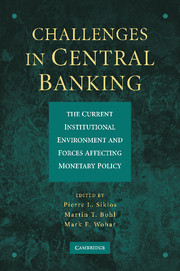 Challenges in Central Banking
Challenges in Central Banking Book contents
- Frontmatter
- Contents
- List of Tables, Figures, and Appendices
- List of Contributors
- Preface
- 1 The State of Play in Central Banking and the Challenges to Come
- PART I PAST, PRESENT, AND FUTURE IN THE CONDUCT OF MONETARY POLICY
- 2 Is the Time Ripe for Price-Level Path Stability?
- 3 The Principal-Agent Approach to Monetary Policy Delegation
- 4 Implementing Monetary Policy in the 2000s: Operating Procedures in Asia and Beyond
- PART II THE SCOPE OF CENTRAL BANKING OPERATIONS AND CENTRAL BANK INDEPENDENCE
- PART III TRANSPARENCY AND GOVERNANCE IN CENTRAL BANKING
- Index
3 - The Principal-Agent Approach to Monetary Policy Delegation
Published online by Cambridge University Press: 06 December 2010
- Frontmatter
- Contents
- List of Tables, Figures, and Appendices
- List of Contributors
- Preface
- 1 The State of Play in Central Banking and the Challenges to Come
- PART I PAST, PRESENT, AND FUTURE IN THE CONDUCT OF MONETARY POLICY
- 2 Is the Time Ripe for Price-Level Path Stability?
- 3 The Principal-Agent Approach to Monetary Policy Delegation
- 4 Implementing Monetary Policy in the 2000s: Operating Procedures in Asia and Beyond
- PART II THE SCOPE OF CENTRAL BANKING OPERATIONS AND CENTRAL BANK INDEPENDENCE
- PART III TRANSPARENCY AND GOVERNANCE IN CENTRAL BANKING
- Index
Summary
Abstract
Recent research in monetary policy emphasizes the endogenous nature of the central bankers' decision process, shifting focus toward institutional structure and “incentive” constraints. Much of this work attempts to mitigate time inconsistency, credibility, and political problems that emerge from this agenda. In this chapter, we present the principal-agent approach to central banking and discuss its relationship to the other institutional designs. We also provide an extensive review of the existing literature on central bank contracts and discuss the related equivalence propositions that emerge.
Introduction
In this chapter, we present the view that monetary policy delegation reflects a principal-agent problem between government (society) and the central bank. The principal (government) delegates monetary policy implementation to the agent (central bank). In the 1960s and 1970s, attempts by government to exploit the apparent trade-off between inflation and unemployment along the short-run Phillips curve led to the idea of the time inconsistency of monetary policy (Kydland and Prescott 1977; Calvo 1978). The resulting inflationary bias in the implementation of monetary policy prompted a search for the “holy grail of monetary policy.”
More recent practical and theoretical developments shift the focus away from the assumption of an inflationary bias. Monetary policy in the standard dynamic stochastic general equilibrium (DSGE) models can typically achieve full stabilization, but nevertheless the absence of an inflationary bias does not suffice to eliminate issues of monetary policy credibility. A vast literature addresses issues of monetary policy design.
- Type
- Chapter
- Information
- Challenges in Central BankingThe Current Institutional Environment and Forces Affecting Monetary Policy, pp. 52 - 82Publisher: Cambridge University PressPrint publication year: 2010
